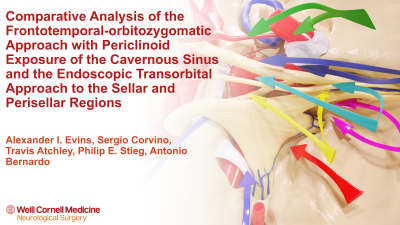Comparative Analysis of the Frontotemporal-orbitozygomatic Approach with Periclinoid Exposure of the Cavernous Sinus and the Endoscopic Transorbital Approach to the Sellar and Perisellar Regions
Friday, April 21, 2023


Antonio Bernardo, MD
Professor of Neurosurgery
Weill Cornell Medicine, Neurological Surgery
New York, New York, United States
ePoster Presenter(s)
Introduction: Several studies have sought to quantitatively compare the traditional open anterolateral approaches with the endoscopic transorbital approach. However, these comparisons have been generally limited to the area of exposure provided by the bone opening and trajectory and fail to account for the main avenues of exposure provided by subsequent requisite surgical maneuvers. We compare the surgical exposure and freedom around key structures in the middle fossa provided by the frontotemporal-orbitozygomatic (FTOZ) and the superior eyelid endoscopic transorbital approaches, and discuss clinical scenarios amenable to each approach.
Methods: Eight FTOZ and 8 transorbital approaches were performed with subsequent surgical maneuvers on 8 cadaveric heads (16 sides). In the FTOZ, extradural maneuvers included cutting of the meningo-orbital band, anterior clinoidectomy, unroofing of the optic canal, opening of the superior orbital fissure, displacement of the extra-annular structures, cutting of the distal dural ring, and interdural dissection. In the transorbital, extradural maneuvers included cutting of the meningo-orbital band, interdural dissection, anterior clinoidectomy, and displacement of the extra-annular structures. The length of exposure of cranial nerves II–V and exposed segments of the ICA and surgical area of exposure of and angles of attack to the lateral wall of the cavernous sinus were measured and compared using neuronavigation.
Results: The FTOZ provided extradural access to the lateral, posterior, and anterior compartments of the cavernous sinus after removal of the anterior clinoid—including the carotid cave—as well as the intradural corridor through the roof of the cavernous sinus medially to the oculomotor nerve with excellent visualization of the medial compartments. The transorbital provided partial access to the lateral compartment. Insufficient application of surgical maneuvers negated access to the cavernous sinus in both approaches.
Conclusion : This is the first study to quantitatively identify the relative advantages of the FTOZ and transorbital approaches at the target region following requisite surgical maneuvers.
Methods: Eight FTOZ and 8 transorbital approaches were performed with subsequent surgical maneuvers on 8 cadaveric heads (16 sides). In the FTOZ, extradural maneuvers included cutting of the meningo-orbital band, anterior clinoidectomy, unroofing of the optic canal, opening of the superior orbital fissure, displacement of the extra-annular structures, cutting of the distal dural ring, and interdural dissection. In the transorbital, extradural maneuvers included cutting of the meningo-orbital band, interdural dissection, anterior clinoidectomy, and displacement of the extra-annular structures. The length of exposure of cranial nerves II–V and exposed segments of the ICA and surgical area of exposure of and angles of attack to the lateral wall of the cavernous sinus were measured and compared using neuronavigation.
Results: The FTOZ provided extradural access to the lateral, posterior, and anterior compartments of the cavernous sinus after removal of the anterior clinoid—including the carotid cave—as well as the intradural corridor through the roof of the cavernous sinus medially to the oculomotor nerve with excellent visualization of the medial compartments. The transorbital provided partial access to the lateral compartment. Insufficient application of surgical maneuvers negated access to the cavernous sinus in both approaches.
Conclusion : This is the first study to quantitatively identify the relative advantages of the FTOZ and transorbital approaches at the target region following requisite surgical maneuvers.
